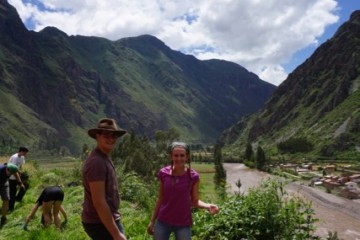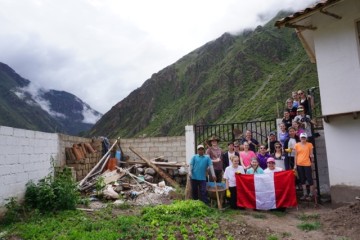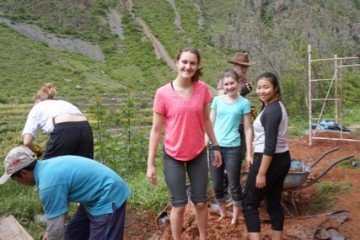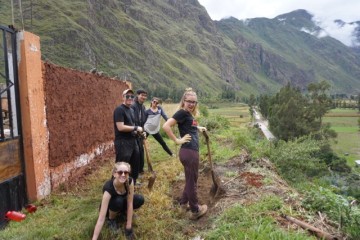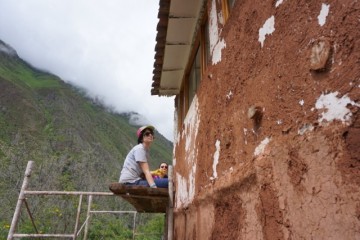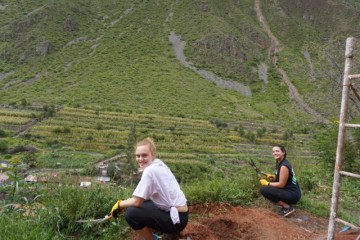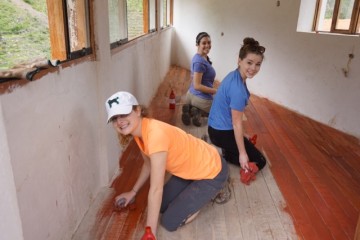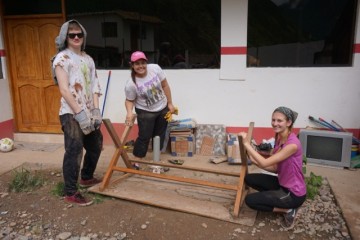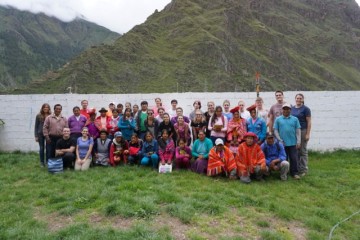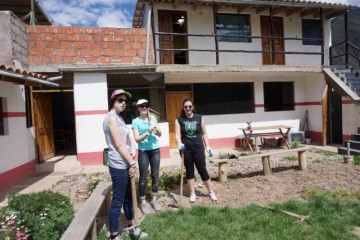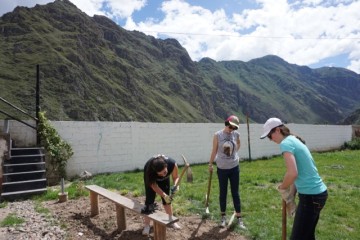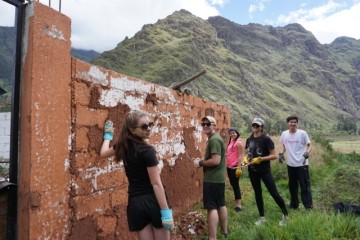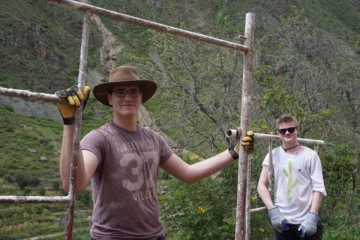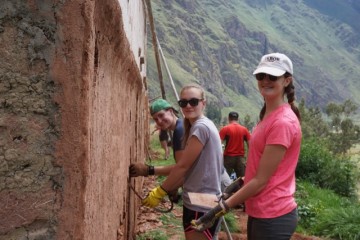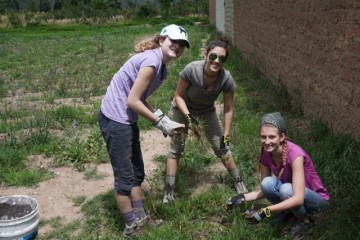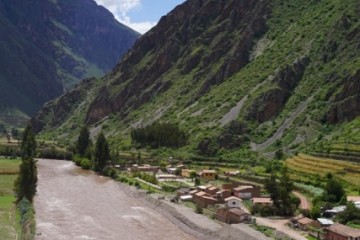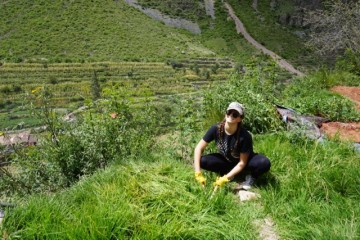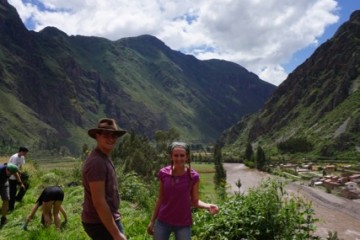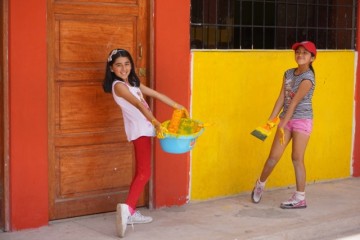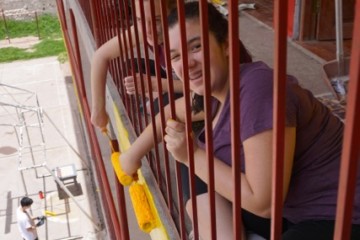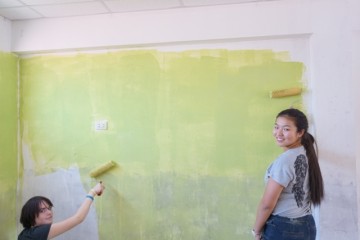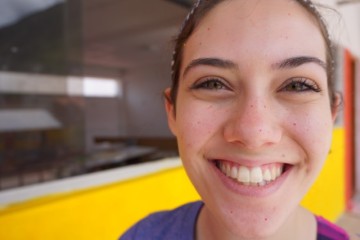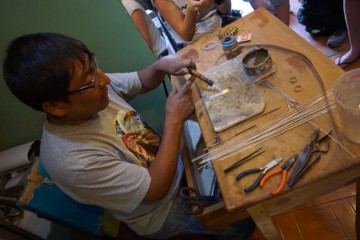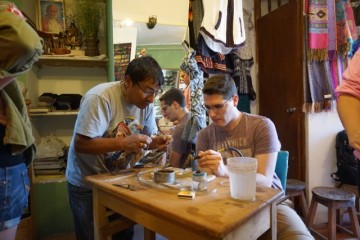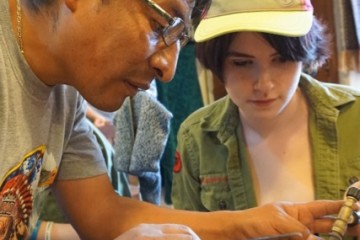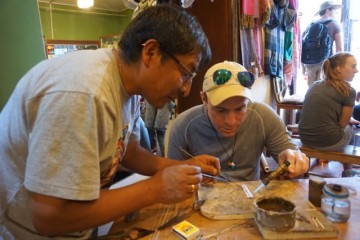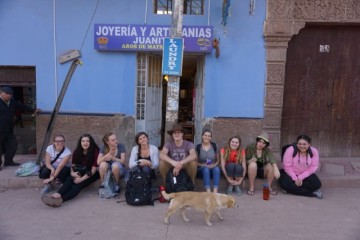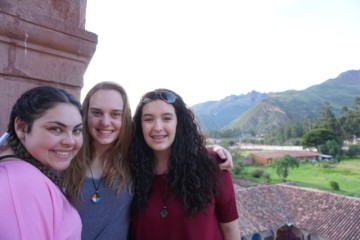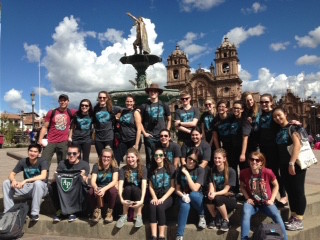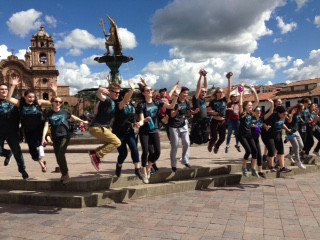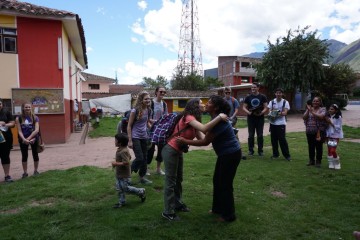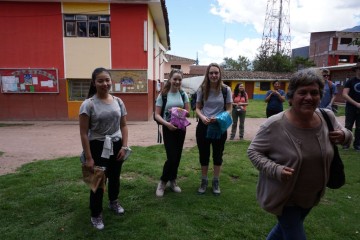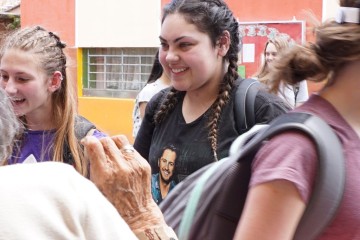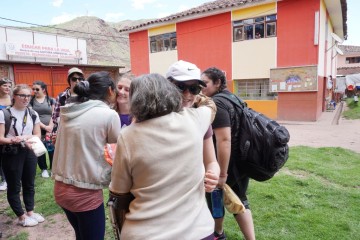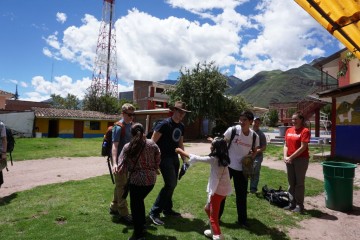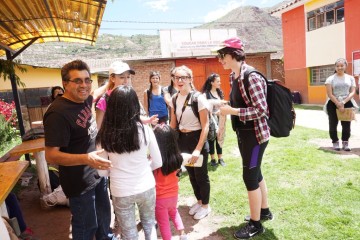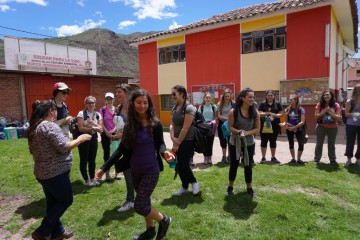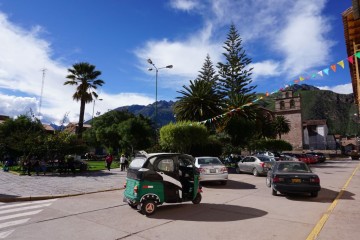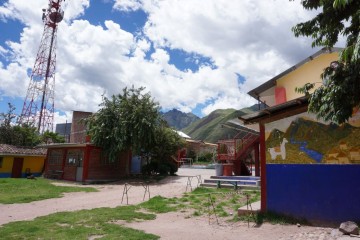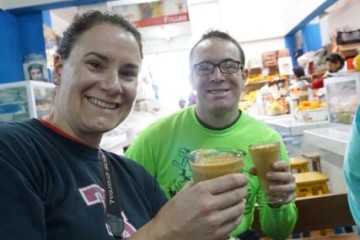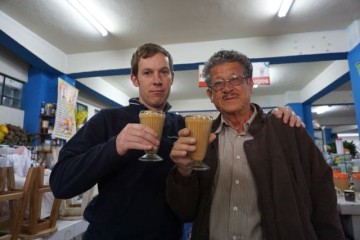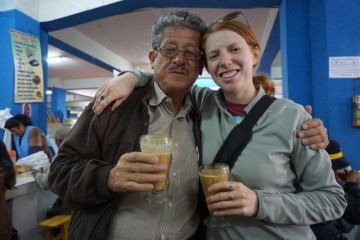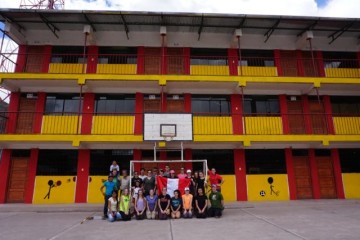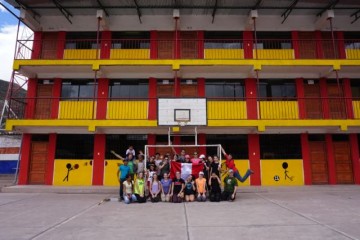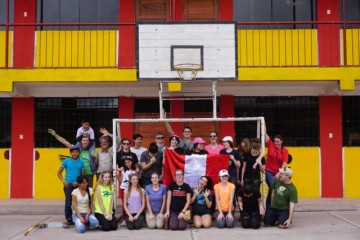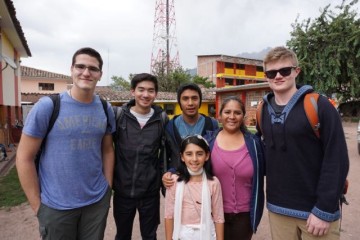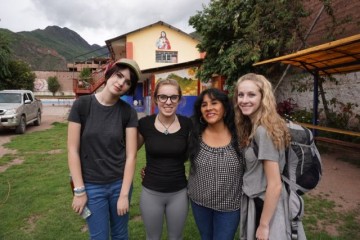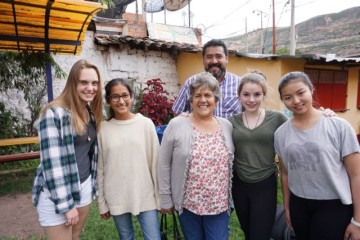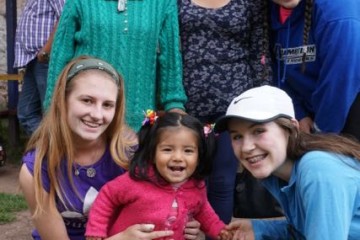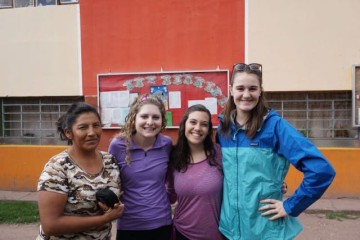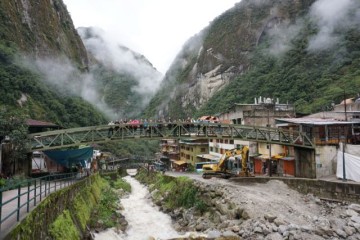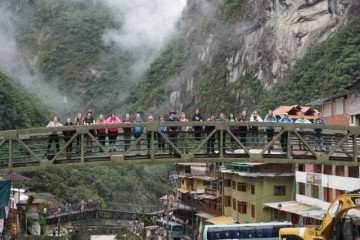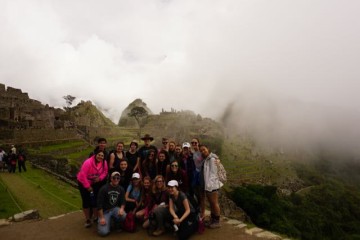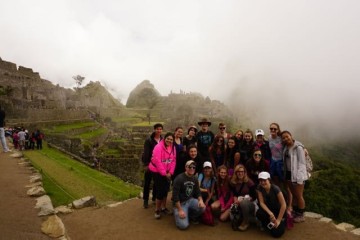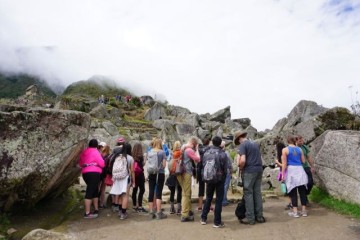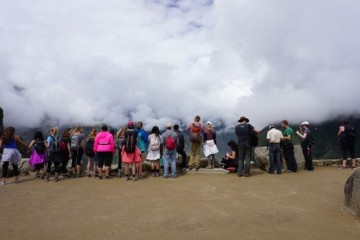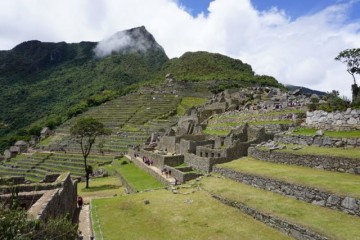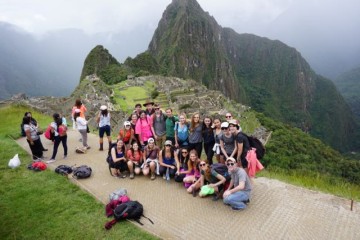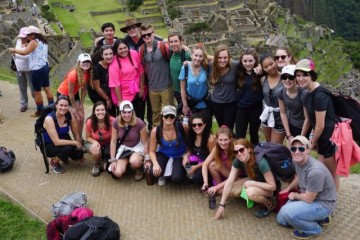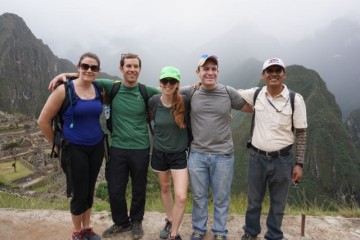Austin Prep Peru Trip Journal (February 12 – 22, 2016)
Trip Journal Update #1
February 12, 2016
February 13, 2016
From the Students:
Today we woke up bright and early to depart from our hotel in Lima where we stayed last night after arriving late from the states. The group had a hearty breakfast of fresh juice, eggs and bread before traveling to the airport. We made it through a breezy one-hour flight to Cuzco. What a scenic ride!! Flying into the mountains and seeing the city of Cuzco nestled among the hills is surly something we will remember forever. We met our second Global Works team leader, Dave, and our local tour guide, Eddie! From the airport we drove to the center of Cuzco, which is called the Plaza de Armas, to do some tourist activities. Lunch was provided at a wonderful shop. We ate sandwiches and drank fresh juices. We then walked around to take pictures and the group exchanged currency – Sols (Peruvian currency) are so cool! After Cuzco, we returned to the bus for a trek up the mountains to an alpaca/llama farm. The views of the surrounding mountains were stunning! When we arrived to the farm, we got to feed alfalfa to our new four-legged friends! The young lady who lived there showed us how to dye and weave alpaca wool.
Everyone took a nap on the bus ride to Urubamba – our next stop. Our group was introduced to a traditional plant that is used by the people in the Adeas in South America. It is called the coca leaf and we learned that this leaf has been used historically here and is an important part of the culture. People chew the leaf and also make tea with it. It is like a caffeinated tea and can help with altitude sickness! We made it safely to our hostel where the group really bonded in the evening. We opened up to each other a lot around the campfire as we shared what we wanted to get out of the trip. This was another memory surly to be cherished forever. To wrap up this blog on a positive note, let’s review today’s funniest moments:
- Chrystal’s water EXPLODING on the plane
- A man in Cuzco called Tori “Shakira”
- Ms. Warner got bit by a llama
Adios!
-Amanda and Liz
Austin Prep spent its first full day in Peru flying from Lima, which is at sea level, to Cusco, which stands at an elevation of 14,000 feet.
February 14, 2016
From the Students:
The day came to meet our host families and the excitement was almost tangible. Some decided to sleep in until breakfast at 9:00 am while others woke up at 6:30 for a meditation service with the family at our hotel. We had a lovely breakfast of bread with homemade jam, fresh squeezed orange juice and eggs. We took some down time to journal about how we were going to make this trip what we wanted it to be. Although we loved our time in our beautiful hotel, everyone couldn’t wait to go to the local school and meet their new Peruvian family. All the families met us at the school and gave us each a gift of an alpaca scarf! The afternoon was spent with each of our families either playing games or seeing the town. Bonds were already forming with our new families on day one.
-Ali & Katherine
From the Chaperones:
Austin Prep students are acclimating to the mountains of Peru. After a solid night of sleep, several students arose early to experience a meditation rooted in traditional Andean cosmology. Elders spoke of the importance of the earth, water, air, and fire to life and the centrality of the sun. An exchange of peace of a hug and the greeting “Buen dia” (happy day) concluded the ceremony. Students shared a simple breakfast before spending time in quiet reflection to journal.
Trip Journal Update #3
February 15, 2016
From the students:
Our first service day of the trip was in Urubamba at the Sacred Heart of Jesus School, also known as Corazon Sagrado de Jesus. We all woke up early in our new homes and had breakfast. Many ate bread, some with eggs or porridge. We walked to the school to meet everyone. It was only morning and the sun was already beating down on us! After quickly talking about our first night in our homestay, we went to work. We separated into groups to tackle our project of painting the school and working on landscaping before the students come back from summer break. One group was taping the walls for precision painting. Another group was weeding an overgrown play area. Yellow and red coats of paint were applied to the school to make it look bright and welcoming. People were trimming down dormant bushes and trees. After a couple hours of work, it already looked like a new school! The principle had recently added new floors to three of the classrooms in the newer building. These walls still needed to be primed and painted; we needed several coats of the light green color. After a hard but very productive first day of work, we all split for lunch. We walked home to our host families for the meal. Many people ate rice with various meats or pasta.
After the delicious lunch, we met back at the school for the afternoon activities. We split into two groups. As one group visited a 17th century Augustine Monastery turned into a beautiful hotel the other group went to visit a ring shop and make our own rings and then we switched. At the monastery we took pictures and walked around the beautiful grounds and chapel. We were able to climb the steep steps of the bell tower. A local artisan couple owned the ring shop. The man, Mario, taught us all how to make silver rings and then we were each able to make our own. We also bought a lot of other jewelry from the shop. After these activities, both groups met back at the ring shop were the nice couple served up guinea pig, or as it is locally know, cuy. Many people tasted the new food and actually said it was very good! We all said goodnight to each other after a long day and parted ways back to our homes for the evening.
-Kelsey & Maddy
From the Chaperones:
At $36 dollars per month tuition, the Sacred Heart of Jesus School in downtown Urubamba is home to 350 students and 29 faculty for primary and secondary school. Several years ago, the school constructed a three-floor, nine classroom addition to be able to allow all students to attend class at the same time. Austin Prep students worked alongside several students from the school to begin several projects which they will finish on Thursday in anticipation of the school returning from summer break on March 1. Students painted the exterior walls of the building and worked inside the Upper School classrooms. Other students cleared the playground area of overgrowth and prepared the soil for new grass. Another team of students clipped back hedges and other plants from the area leading up to the school’s grotto.
February 16, 2016
From the Students:
The first day at the Sacred Valley Project, we learned in more detail about the true struggle of the girls who come to stay in these dormitories in order to study in Ollantaytambo. The girls walk up to 6 hours to try to get an education. We can’t even imagine what it would be like to not be able to drive to school every morning. These girls are taught more than just history and science and English, these girls learn helpful skills such as photography and baking, and self-confidence. Many of these girls are from such rural areas where modern culture hasn’t appeared yet, and abuse isn’t uncommon. Our projects here are to make the dormitories nicer for the girls before coming back to the dorms from the mountains for summer break to study. We were building a new mud wall and doing many other projects around the building. We got to learn the traditional techniques of building with mud, some even took off their shoes and stomped on the mud to mix it! Ms. Warner asked us before we started our work what our individual thoughts were on one of Austin’s word, Veritas. After awhile of thinking, many agreed that veritas meant to us to be our true self. Back home, our lives circle around the use of a 6-inch electronic device, that makes it hard to take time to think about ourselves. Most of the time we don’t take the time to push ourselves to see what we are actually capable of. If we don’t test are boundaries, how will we know what we could’ve accomplished in our lifetime? We agreed that being on this trip is pushing us to some limits, some past our limits. Being on this trip has shown us that it is okay to make new limits. It is just so crazy how innocent the world can seem from a far, or even from a different view. We are grateful to get to see the rougher side of life here in Urubamba, because when people live sheltered lives it always comes back to bite. Luckily, not only did we get to see the tougher parts, we got to improve upon them; making it that much more important for us to be on this trip. In the afternoon we all went to a ceramic shop and made our own ceramics. It was a nice end to a hard working day.
-Kate and Grace
From the Chaperones:
Have you seen the documentary “We go to School”? The film traces the long, often dangerous, journey that girls in underdeveloped countries must take to arrive at their classrooms order to receive even the most basic education. For the girls in the mountainous region of Peru, this is a daily reality. When Austin Prep students arrived at the dormitories of the Sacred Valley Project in Ollantaytambo, one of the managers of the Project, Gabriella, asked students about how long it takes them to get to school and how do they get there. Ranging from walking two minutes to driving a half hour, Austin students’ commutes are a fraction of the three to six hour walk to a road plus a drive that the girls who the Sacred Valley Project assists make. In the mountains, girls only receive a basic primary education. Families may pay for a room in town for a son to continue his studies, but this is uncommon for daughters. The Sacred Valley Project houses 16 girls ages 11-17 so that they can attend school in town. In the afternoon, they take extra classes and also engage in activities designed to give them a skill to enable them to break out of the cycle of poverty in which they live.
We started our day off by heading for a second day to the Sacred Valley Project in Ollantaytambo. A lot of progress was made the day before so everyone was eager to finish the job and give the girls living there a beautiful living space. The group divided and conquered. Some were re-patching the clay wall, a few waxed the floors in the upstairs dormitory, many leveled the entry walkway and others transformed an old looking picnic table into a great new piece of furniture.
We were also lucky enough to get to meet a few of the girls who live in the dormitory, as there was a parents meeting this day. The families had all walked several hours from their surrounding villages to come to the meeting. After going around in a circle saying their names, ages and favorite subject in school, the girls also told us on average how far their walk to school was. On average each family had to come at least 2-4 hours to arrive in Ollantaytambo, where the girls’ school is. We were given the opportunity to donate some supplies to the girls and it was so heartwarming to know that Gabriella and Felix (staff at the dormitory), the girls and their families were so grateful. After the girls had left we sat down for a well deserved break. Everyone indulged on bread and homemade guacamole, courtesy of Grace and Kate…. thank you! With an hour left after the break for service work, we were able to get all of the jobs done with amazing results! The mud wall looked amazing and we felt very proud.
Onward we went to Pisac Market! It is a famous market in the area for it handicrafts. The group split into small groups of three and each group was given some money to buy their own lunch around the plaza. Some went to enjoy the famous empanadas while others shopped around the market. We all left happy with our new items, whether they were rings, toy alpacas, scarves, etc. Then we all went back to our families to get ready for one last dinner with everyone together. This goodbye celebration is called the “desepidida. It was a delightful dinner of pizza and cake. All the students read cards to our host families, giving them thanks for their open arms and hospitality. Although we all had to attempt to speak Spanish, the families understood and loved our words. It was a great way to end the last night with our families!
-Emma & Gianna
We woke up to the sounds of roosters crowing in the early morning light. Knowing that we needed to be ready for our next day of work, we quickly got dressed and went to breakfast, where we had a delicious dish of chicken and rice with peppers and onions. That distinct smell of chicken permeated the dining room as our taste buds were stricken by a frenzy of tastes – each complimenting each other very nicely. As we were eating, we were excited to be able to complete our service work, but we were also sad knowing that this would be our last day with our host families. After finishing our breakfast, we began to walk toward the school where we would be working, and, to our delight, our host sister, Asmir, decided to help us. After a five-minute walk, we arrived at the school and met up with the rest of our group. There was a sense of urgency, however, because there was so much to do in so little time.
When we arrived, we quickly set out the supplies we needed and went about finishing the jobs we had been assigned. This included putting on a second coat on the walls we had painted, completing the work we had done on the stairwells, and drawing murals that included scenes of people playing sports and an Augustinian emblem. Since it was a really hot day, we were constantly running to put on sunscreen and to drink water. After a few hours, we had a quick snack break, where we experimented new fruits such as maracuya, papaya, and granadilla. After the fruit, we enjoyed a sort of caramel cinnamon roll and drank Coca-Cola and Inca Kola, a popular soda available in Peru. Afterwards, we all went back to work and put our efforts into one final push.
All around us, our group-mates were running around frantically mixing paint and trying to fill in paint spots that we had missed on our first attempt. We had managed to finish most everything by the time we had to go – even finishing a classroom on the third floor that had to be painted with two subtle shades of green. After the real work had been completed, we were tasked with collecting the paint that had not been used into their respective buckets and scrubbing the containers we had used for painting. We became aware of the fact that very little was thrown away, and most things were going to be reused. Afterwards, we took a group picture and went back home to spend some final moments with our host family.
When we got home, the first thing we did was take a shower because we were covered in paint and sweat. The warm shower felt really nice after a day of hard work. Afterwards, we had our final meal with our host family. We went back to our rooms and rushed to pack up so we could fit in one final game of Uno in which Emerson, Madre, Padre, and Asmir, and us all played together. After Asmir destroyed all of us at the championship game of Uno, it was time to go back to the school. Everyone else in the group also has one last amazing meal with their families.
We took a lot of last minute pictures before we left and exchanged our Facebook, addresses, and e-mails. The walk to our school was both sad and exciting. It was sad because we were leaving our host families, but it was exciting because we were starting our next adventure. When we got to the school, we took a tour around the school to see the culmination of many hours of sweat and toil. We went into a reflection circle to talk about our experiences and our interpretations of service. Although there were a lot of great answers, the one that stood out to us the most was Mr. Mclaughlin’s answer. As tears were streaming down some of our faces, he said these tears were not only tears of sadness but also tears of joy. He also told us that even though only a few kids from Austin Prep are here at Urubumba, the whole Austin community is with us because they are part of our hearts and mission to serve others. After the circle, it was finally time to say our final goodbyes.
The last goodbyes were very emotional. We first said our goodbyes to our host families with hugs, kisses, and tears. Even Fuego, the stray dog we had “adopted,” came to say his last goodbyes. As we boarded the bus that would bring us to Ollantaytambo, we felt a lack of closure as we pulled away from our host families. Despite giving them our farewells, we weren’t ready to leave. Over the past few days we had really developed a bond with our families, and it was hard to swallow the fact that this may be the last time we’ll every see them again. As the bus finally pulled away we took a look back and saw our host families crying, making this goodbye even that much more heart wrenching,
The sadness in our hearts was replaced by excitement and happiness. On the way to Ollantaytambo, the bus ride was rather interesting as we engaged in a few rounds of karaoke. Pedro started off with I’ll make a Man out of you, followed by others attempting to sing songs such as Hello by Adele andShake it Off by Taylor Swift.When we finally arrived at the plaza of Ollantaytambo, we walked to an ancient Incan fort and proceeded to shop at the market just beneath the base of the fort. We went back to the plaza to reflect about our experiences with our host family.
In this reflection circle, we talked about what we learned and the similarities and differences between the host family’s home and our homes. Finally, Dave unveiled the rings we had made at Mario’s jewelry shop a few days prior and told us to randomly pick a ring from the envelope. When one of us picked a ring, we would hand that ring to whomever it belonged while saying something nice about them. After we finished our reflection circle, we needed to follow Eddy to the train station. By this point it was nearly sundown, and after the ten-minute walk, we boarded the train and enjoyed our ride to Aguas Calientes. Before we got on the train, many of us noticed how the train resembled the Hogwarts Express.
We got in late to the town of Aguas Calientes but we greeted at our hotel with a hot meal before heading off to bed. It was nice to be together again as a group and we were all anxious to wake up the next morning for our trip to Machu Picchu! -Tori and Emily K.
At 6:30 we were blessed with an early wakeup call by Ms. Warner but eventually everyone got ready and was gathered into the breakfast room. Once everyone had at least downed a plate of food, everyone took snacks from the piles in the lobby. We separated the things that we were going to bring to Machu Picchu and the things that we were going to leave at the hotel and placed in the hotels safe. With filled water bottles and raincoats the group made their way to the bus station to reach the summit of Machu Picchu. Edison passed out the bus tickets and we all boarded the bus. While driving to the summit, the cloud covered mountains and lush green vegetation stretched as far as the eye could see; you could defiantly see why it was called the cloud forest.
Once reaching the summit, we once again were passed out our Machu Picchu passes and passports and entered through a shaded bridge feeling the humidity and heaviness of the low altitude. Since it was early in the morning, the clouds were very thick and dense so it looked as if there were no mountains surround us, just an endless white expanse. Edison led us through some of the terraces, pointing out a few of the 16 fountains in the site, also telling us that due itself doesn’t have a lot of water, only enough for about 200-500 people. Traversing the narrow pathways and entranceways, we noticed the impeccable stone work and construction of the entire city. Edison also pointed out that only some buildings and structures had more precise stonework than others, if a house had more definite and neat stone work, it meant that the inhabitants were of royal or noble status. Bringing us to one of the nicest house in the site, Edison explained that it must have belonged to a high priest or noble. With two bedrooms and an outside courtyard, the house was separated into the bedroom for the noble and his wife and the other bedroom was for their children. Entering the rooms, through a small corridor enough to fit only on person at a time, you could catch a small glimpse of a shower and the remnants of a bathroom. In the room for the children, you could see that the bathroom was more open without a shower. Moving on from the house we moved on to the sun temple of the Incas. We first walked around to the left side of them just enough to see the window at the front and the side of the temple. Edison explained to us that the window in the front was meant to capture the light of the sun on the day of the summer solstice and the one of the right side pointed directly south. He went on to explain that the window on the right side seemed to be very much damaged and cracked, this was due to a lightning bolt that struck the temple and damaged the infrastructure. This was one of the many reasons that the people of Machu Picchu decided to leave. He went on to explain that the Incans were very superstitious people so they viewed this strike as a warning. Moving down the steps towards the front part of the temple, you could see another window on the left side of the temple as well; this was meant to point towards that sun on the summer solstice. And when you look underneath the temple, you could see a cave with niches, sacrificial altars, and steps, the niches would indicate that they were meant to hold statues or symbols but when the explorers discovered the cave, it held nothing of the sort.
Continuing down the stairs we passed more examples of the amazing stonework then we went around seeing the green area in the middle of Machu Picchu, as Edison had said that this is where the leader would address the people of the city. When we started to walk around the plaza, we saw llamas napping and resting on the green surrounded by the stone structures of the city. On one side of the plaza there was a staircase leading to the sun stone, which is a kite-shaped with the intention to mimic the constellation of the cross, in which each point directed to the four cardinal directions: north, south, east, and west. This was intentional by the Incas to match the stone to the constellation. Going down from the sun stone we passed by the front part of the plaza, seeing the stone structures in the shadow of the mountain towering over the whole site. After having a small break, we headed to the exit to take a formal break and also to decide and split into who was going to climb to the sun gate. Everyone re-entered the site and we climbed up a windy and steep path to get to the top of the terraces overlooking Machu Picchu and Huainaicchu in the distance, the perfect picture spot. Once everyone had taken their photos, it was then decided who was going to hike to the sun gate and who was going to stay and explore the site. About two hours later, the group with Edison came back from the sun gate and met the rest at the entrance. We excited the site, got our bus tickets, and headed off down to Machu Picchu town to catch the train back to Cusco.
Once on the train, we realized that our group was the only people on the train car we decided to play card games and just chat amongst ourselves. Our train actually stopped at a station close to Cusco but we still needed to take a bus to get to Hotel Los Ninos. After about an hour bus ride, we reached our hotel, soon did we learn that all of the funds we payed towards staying here goes to underprivileged children to give them the necessities that they need. Once everyone was situated into their various rooms, we sat down to dinner and then went to bed, glad that we didn’t have to wake up so early the next day.
-Tori & Emily
Trip Journal #5
February 20, 2016
From the students:
Today was one full day in the beautiful city of Cuzco! Our group was so excited to hear that were would have some time to sleep in today as we were all exhausted. When we awoke, we were treated with an amazing breakfast of fresh baked bread and juice from Los Ninos hotel. Our first activity of the day was a scavenger hunt through San Pedro market. We were given a list of things to buy and money. We had 45 minuets to purchase a bunch of food items as well as gloves and a hat that afterwards we were able to give to a person living on the street. It was a really powerful feeling to be able to help someone out so much. We also all got to practice our bargaining skills a bit more!
Next we headed to the Inca Museum to see a bunch of beautiful artifacts and learn a bit more history. Our lunch was free to go in groups of three around the plaza. A few of us age pasta and pizza while other were more adventurous and ate some alpaca! Although we were getting tired, there was one more historical site we wanted to see. We made a stop at the Sun Temple to see one of the most important holy sites for the Incas. This site has since been built over by the Spanish colonists but it is a beautiful mix of the two cultures and architectural styles.
As was already mentioned, we are staying at a hotel called Los Ninos (or “The Children’s Hotel”). In the afternoon we got to go and visit the organization associated with this hotel and learn about the poor children that the hotel helps support through soup kitchens, tutors and other community centers in Cuzco. It was so inspiring to the whole group to see the impact this organization had made on so many kids lives and we all wanted to find someway to help in the future.
Tonight was our final group dinner. Many ordered an alpaca steak or a traditional dish called lomo saltatdo (a beef stir-fry) for the final meal. It was fun to be together one last night and all play riddles around the table. We ended by giving each other paper plate awards and little finger puppets of the “spirit animal” we best thought represented one another. It was a great night and cool to see how close the group had become over this amazing trip.

